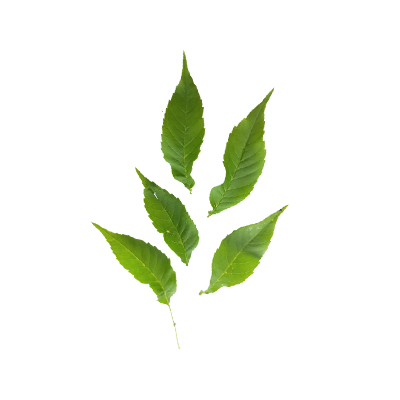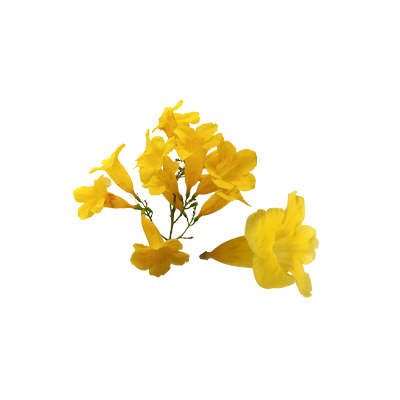Yellow Bell
Tecoma stans (L.) Juss. ex Kunth
Bignoniaceae
Location in our garden
Principal
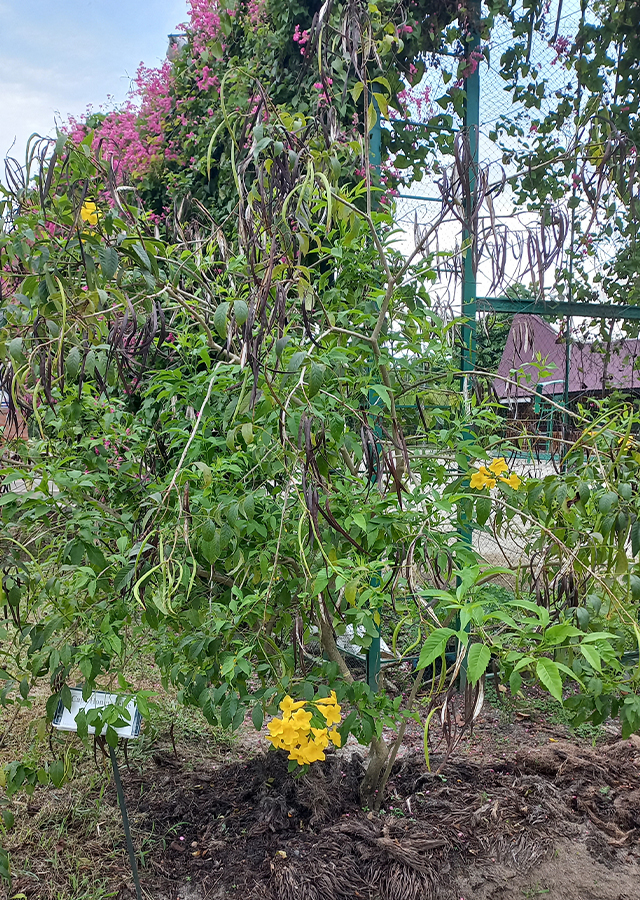
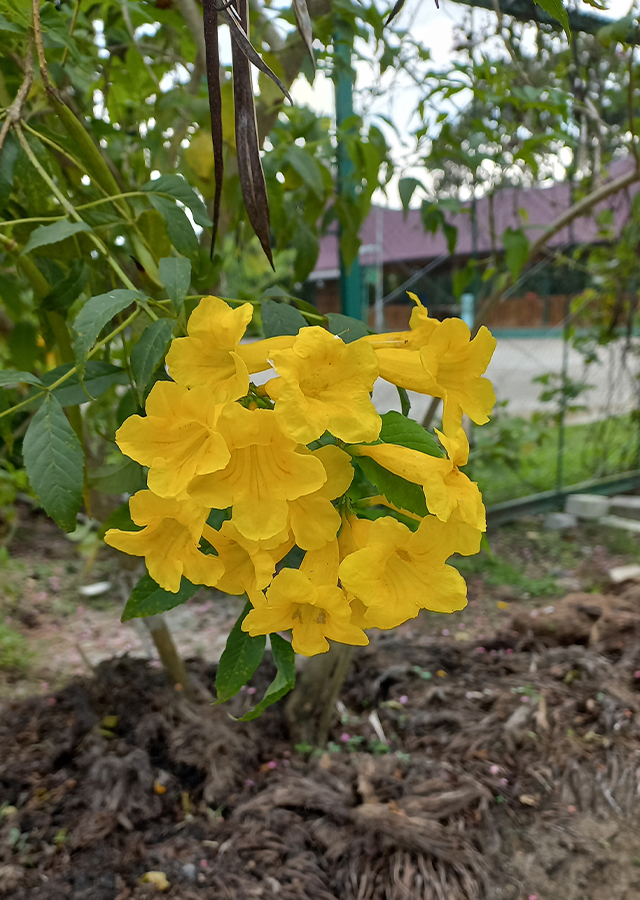
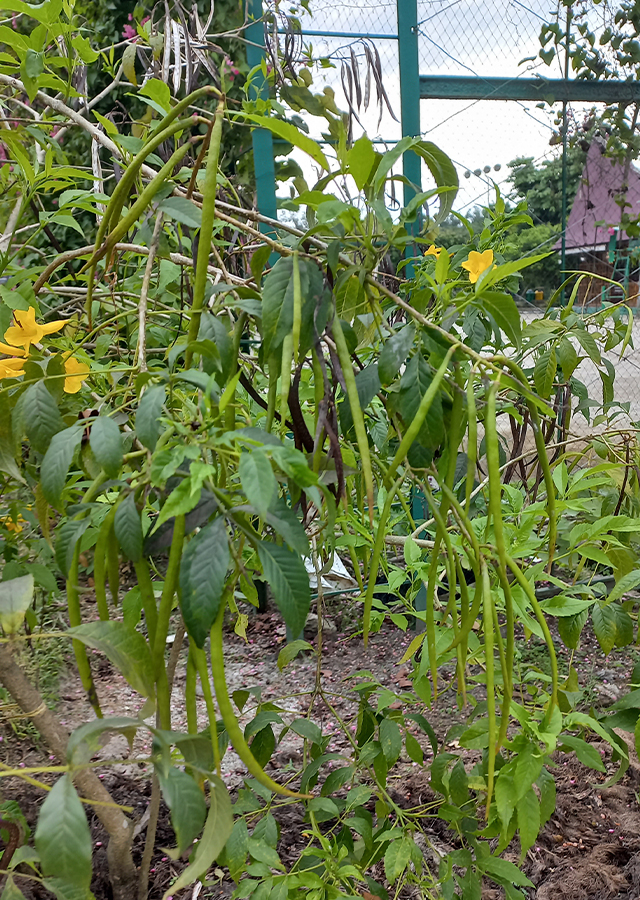
Synonym
Bignonia stans L.
Gelseminum stans (L.) Kuntze
Stenolobium stans (L.) Seem.
Habitus
Shrubs. A fast-growing shrub or small tree, perennial, that can reach a height of 5 - 8 metres.
Part Used
Leaves
Bark
Flowers
Roots
The Whole Plant
Growing Requirements
Full Sunshine
Need Shade
Drought Resistant
Habitat
Riverbanks
Forest
Roadside
Grassland
Terrestrial
Overview
Tecoma stans is native to America. It is an ornamental plant and official flower of United States, Virgin Islands and National flower of the Bahamas. It has cosmopolitan distribution throughout India and also has been listed as a noxious weed in South Africa, Australia and America. The plant sometimes cultivated as a hedge and to provide shade, wood producing, and medicinal plants. The wood is hard and very durable. It is used in cabinet making, turnery, to make tools, and in the construction of buildings. As a medicinal plant, the leaves of Tecoma stans have been used traditionally throughout Mexico and Central America to treat diabetes and urinary disorders control.
Vernacular Names
Lluvia de oro, Trompeta, Trona frente, Tronadora (Spanish), Tecoma jaune (French), Amarelinho, Ipê-mírím (Portuguese), Aufrechte Trompetenwinde (Germany), tecoma giallo (Italy), Sona pata (Bangladesh), Kinreiju, Kinreiju, Tekoma sutansu (Japanese), Tong u rai (Thai), Piliya, Pillakaner (Hindi).
Agroecology
Yellow bell is a plant of drier areas in the tropics and subtropics, it can be found at elevations from sea level to around 2,000 metres. Plants are often found growing along steep gradients, road sides and eroded and overgrazed areas, undisturbed forests. It grows best in areas where annual daytime temperatures are within the range 15 - 25 °C, but can tolerate 10 - 35 °C, with a mean annual rainfall in the range 500 - 700 mm, but tolerates 400 - 800 mm. Yellow bell is requires a sunny position and can grow best in clay loams, but tolerates most types of fertile, well-drained soils and is particularly tolerant of alkaline conditions. Prefers a pH in the range 6 - 8,5, tolerating 5,5 - 9. Established plants are drought tolerant.
Morphology
- Roots - taproot.
- Stems - branched, sparingly hairy or nearly smooth .
- Leaves - opposite, stalked, compound leaves are pinnate, bearing 3-7 elliptic to elliptic-ovate leaflets with toothed margins. Bright green above, paler below and can be smooth or hairy, often around the veins, depending on the region (subspecies).
- Flowers - fragrant, bright yellow tubular flowers with 5 rounded lobes are borne on a short, upright, terminal inflorescence or subterminal with up to 20 flowers about 50 mm long. Calyx is green and in some varieties the corolla is slightly orange-yellow with pinkish lines in the throat.
- Fruits - a linear shiny capsule and flattened, measuring up to 30 cm long and 2 cm wide, pointed at the end. The fruits matures from green to brown and split open to release numerous seeds which are papery and winged.
- Seeds - numerous, flat, and oblong in shape, measuring up to 8 mm long and about 4 mm wide. Together with the wings, they are about 2 cm long and 0.8 mm wide.
Cultivation
- Propagated by seed (generatively) and cuttings (vegetatively).
- Seedlings require 3 - 4 months in the nursery, after which they can be directly planted out.
Chemical Constituents
Tannins, flavonoids, phenolic compounds, coumarins, glycosides, cardiac glycosides, alkaloids (tecomas tamine, tecomine, boschniakine, and 5-hydoxyskitanthine), monoterpene alkaloids, steroids, anthraquinones, saponins, polyphenols, α-linolenic acid, oleic, linoleic, palmitic , stearic acid, γ-tocopherol, sesquiterpene lactones, quinones, phytosterols, triterpenes, iridoids.
Traditional Medicinal Uses
- Ground roots applied to snake bites; with lime juice drunk in small amounts for the same.
- A strong leaf and root decoction is taken orally as a diuretic, to treat syphilis or for intestinal worms.
- In Bangladesh, leaves used for pain, also for piles.
- The flowers are diuretic.
- Flower infusion can be taken orally for diabetes and stomach pains.
- Considered diuretic, tonic, anti-syphilitic, and vermifuge.
Part Used
Reference Sources
- Useful Tropical Plants Database. 2021. Tecoma stans. http://tropical.theferns.info/viewtropical.php?id=Tecoma+stans. 23-12-2021.
- PROSEA. 2018. Tecoma stans (PROSEA). https://uses.plantnet-project.org/en/Tecoma_stans_(PROSEA). 23-12-2021.
- CAB International. 2021. Invasive Species Compendium: Tecoma stans (yellow bells). https://www.cabi.org/isc/datasheet/52951#touses. 23-12-2021.
- Flora Fauna Web. 2021. Tecoma stans (L.) Juss. ex Kunth. https://www.nparks.gov.sg/florafaunaweb/flora/3/1/3177. 23-12-2021.
- Stuartxchange. 2018. Philippine Medicinal Plants: Yellow bell. http://www.stuartxchange.org/YellowBell. 23-12-2021.
- Khatak S., Malik D. K., Dahiya R. 2019. Tecoma stans: A noxious weed put to beneficial use. International Journal of Chemical Studies, 7(3): 296-299.



